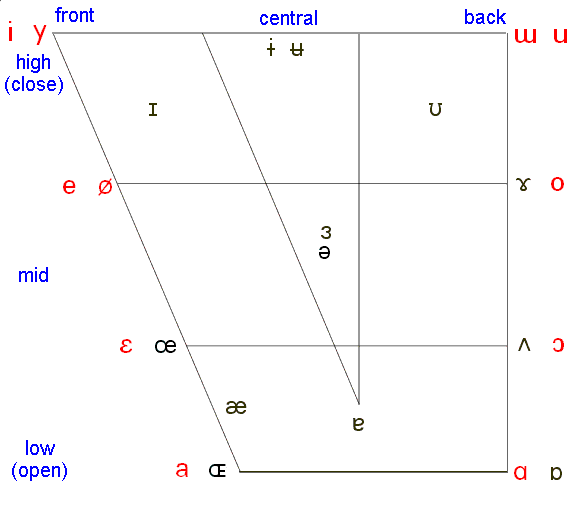IPA Vowel symbols
IPA Vowel Symbols
The following table shows most of the vowel symbols defined in the current version of the International Phonetic Alphabet. This table represents the vowels symbols that you will need to know for this course.
In this table the "vowel quadrilateral" roughly represents tongue position, with positions to the left of the diagram representing vowels produced with the tongue moved towards the front of the mouth and with positions to the right of the diagram representing vowels produced with the tongue moved towards the back of the mouth. Similarly, high positions on the table represent vowels produced with a high tongue position and low positions on the table represent vowels produced with a low tongue position. The third dimension on this table (represented implicitly by the paired vowels) represents lip posture (spread versus rounded lips).
Four IPA vowel symbols have been omitted. The missing vowels are:->
- [ʏ], the rounded version of [ɪ]
- Three central vowels, including the rounded version of [ɜ]

| Recorded examples have been supplied for each of the symbols in red. CLICK ON THE RED SYMBOLS TO HEAR THE EXAMPLE . |
Rounded and Unrounded Vowels
In this diagram, whenever there is a pair of symbols together, the sounds only differ with respect to lip posture, with the left symbol being unrounded and the right symbol being rounded.
Rounded Vowels
The rounded vowels on the above diagram are:-
[yø œ ɶ ɒ ɔ o ʊ u ʉ]
Unrounded Vowels
The unrounded vowels on the above diagram are:-
[i ɪ e ɛ æ a ɐ ɑ ʌ ɤ ɯ ɨ ɜ ə]
Cardinal Vowels
The 16 cardinal vowels are sub-divided into 8 primary and 8 secondary cardinal vowels. The first five primary cardinal vowels are unrounded and the last three are rounded. The first five secondary cardinal vowels are rounded and the last three are unrounded.
The primary cardinal vowels (1 -8) are:-
[i e ɛ a ɑ ɔ o u]
The secondary cardinal vowels (9-16) are:-
[yø œ ɶ ɒ ʌ ɤ ɯ]
When you compare these symbols with their position on the diagram above, you will see that each set is a mixture of unrounded and rounded vowels and that the secondary set is identical with the primary set with the exception that the lip posture is reversed.
The primary cardinal vowels tend to be much more commonly found in the world's languages than the secondary cardinals but the three secondary cardinals highlighted in red are also very common. For this reason, sample recordings are provided for these 11 cardinals.
The Position and Nature of the vowels [ɜ] and [ə]
Note also that the true position of [ɜ], according to the current version of the IPA, is about half way between where it is on this diagram and the position of the vowel [ɐ]. In the IPA the vowel [ə] is the true central or neutral vowel. The vowel [ɜ] has been placed in the same position as [ə] because it is a convention in both Australian and British phonetics to use [ɜ] as the long central vowel and [ə] to represent the unstressed, reduced schwa vowel. Students should expect to find in American texts the symbol [ə] being used to represent the unreduced fully-realised central vowel.
Content owner: Department of Linguistics Last updated: 12 Mar 2024 9:25am
